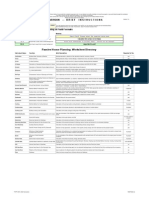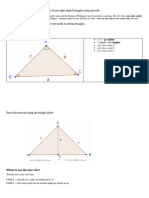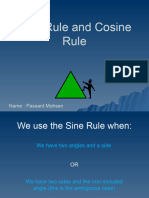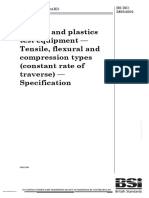ARE Structures Cheat Sheet PDF
Uploaded by
DrewARE Structures Cheat Sheet PDF
Uploaded by
DrewThe Non-User's Pocket Guide to the Transient Knowledge Necessary for the Structural Divisions of the Architect Registration
Exam- ARE
CONCEPT FORMULAE AND DIAGRAMS COMMENTS
Memory Trick: SOHCAHTOA (Indian Tribe) used when triangle has a 90º angle.
c (Rise)
Sin C = OPP or Rise or B SIN RISE
HYP Slope a 90º triangle COS RUN
TAN SLOPE
Run b (Run) a SIN and COS of any angle are between (+/-) 1
Cos C = ADJ or
or c
Slope a 0º < angle < 45º COS > SIN
Trigonometry/Math
HYP
45º < angle < 90º SIN > COS
C
OPP Run c
Tan C = or or (Slope) A b
ADJ Rise b
Law of Sines Law of Sines and Cosines are used when triangle has no
a = b = c B Non- 90º Triangle right angles.
Sin A Sin B Sin C Law of Sines is used when you are given more angles
a than sides.
a2 = b2 + c2 - 2bc (Cos A) c
Law of Cosines
b2 = a2 + c2 - 2ac (Cos B) Law of Cosines is used when you are given more sides
A than angles
c2 = a2 + b2 - 2ab (Cos C) b C
Variations in L.O.A. P Properties of a Force: A Force is defined by four properties:
1. Point of Application (P.O.A.)
P Py 4 2. Magnitude ( #,kips )
Ø Py Ø 3 3. Sense (Arrowhead, Push or Pull, C or T)
2 4. Line of Action (L.O.A.) , (Angle with horizontal)
Px PX k
1 1000# = 1 The Resultant of several forces is a single force that has the
Shallower angles (<45º) have Steeper angles (>45º) have Ø
same effect on a body as all the other forces combined.
larger horizontal components larger vertical components
The Resultant is also a force and is thus defined by the
four properties listed above.
Components of a Force:
The Equilibrant is also defined as a force that has the
P
P PX Px same P.O.A., Magnitude and L.O.A. as the Resultant
Py Py but has an opposite sense (Arrow)
Py P Py
Py Algebraic Method for finding the Resultant of several
PX P Py
PX P
forces is used when force magnitudes and lines of
PX PX action for each force are known
Forces
Variations in Sense: Transmissibility: Algebraic Method of Force Addition
P P 1. Resolve each force into vertical and horizontal
P Py P components
Py 2. The algebraic (+/-) sum of all horizontal components
=
PX PX gives the horizontal component of the Resultant.
P 3. The algebraic (+/-) sum of all vertical components
Force Addition: gives the vertical component of the Resultant
Algebraic Method: Graphic Method for Force Addition:
For finding the resultant of several forces For finding the Resultant of several forces. Graphic Method is used when a system is in equilibrium
and we need to calculate one or more unknown forces
Force Horizontal Vertical 2 3 2 that contribute to equlibrium
2 1 3
1 +/- +/- 2 1 R Graphic Method for Force Addition
2 +/- +/- 1 1 1. Arrange all forces Head to Tail then add (independent
3 of order)
3 +/- +/-
3 2. Resultant begins with its Tail at the Tail of the 1st Force
R +/- R X = ΣX +/- R y = ΣY Tail of 2 on Head of 1
Resultant begins at 1s Tail and Head at the Head of the last
Tails at same P.O.A. Tail of 3 on Head of 2 and ends at last Head 3. Resultant can be determined through calculation
September, 2004 © 2004 David J. Thaddeus, AIA PAGE : 1 OF 4
The Non-User's Pocket Guide to the Transient Knowledge Necessary for the Structural Divisions of the Architect Registration Exam- ARE
CONCEPT FORMULAE AND DIAGRAMS COMMENTS
Moment A & B are called Centers of Moment, or Centers of
Moment = Force X Distance P Rotation
The perpendicular distance (d) is called the Moment Arm,
A B
or Lever
Force P creates a Force P creates a Summing Moments (∑M = 0) to establish equilibrium
Moments and Couples
Positive Moment _ Negative Moment To find Beam / Truss reactions
_ about point A + about point B To maintain equilbrium of members
CCW + CW d d Overturning Moments due to Wind Loads or Hydrostatic
Pressure
Couple Unlike a Moment, a Couple is NOT about a certain point,
P but rather it is about ANY and ALL points.
Moment of a A Couple depends on Force (P), and perpendicular distance (d)
Couple= P x d between two Forces that make up the couple.
d
d
(clockwise, CW) P ( CCW ) Couple between top Chord (C) and bottom
P chord (T) in a simply supported truss
Couple between compression in concrete ( top ) and
tension in rebar ( bottom ) of reinforced beam
Formulas Units 1. ELASTIC RANGE: straight line relationship, slope = E
1 2 3 4
P 2. PLASTIC RANGE: increase in strain, no increase in Load / Stress
F: Direct Stress PSI Fu
5 3. STRAIN HARDENING: material deforming in section (necking),
A
Stress / Strain
Fy 6
7 and in length
ΔL 8 4. FAILURE: Material is gone!
ε: Unit Strain in / in
Stress (F=P/A)
Lo 5. YIELD POINT/ YIELD STRENGTH: material is no longer elastic,
Modulus of deformation is permanent
Modulus of Elasticity: E
F 6. ULTIMATE STRENGTH: material is about to fail
E: Elasticity= PSI (slope)
ε Stress / Strain
Unit Strain ( ΔL/ L0 ) 7. RUPTURE: Kiss it Good-Bye
ε 8. E: Modulus of Elasticity.Measures material's resistance to deformation
ΔL: deformation, changes in Length (in) EA36,A-50= 29,000 KSI ΔL = α (ΔT) L0 Shortening or Elongation of members along their axis
caused by Axial Load (P) ΔL: Deformation, change in length (in), Change (Expansion & Contraction) of shape
Axial Loads
P : Axial Load (#,k) caused by change in temperature (ºF) due to Temperature
ΔL= PL0 P ΔL
L0 : Original, undeformed Length (in. not ft.) ΔT: Change in temperature
AE L0 ΔL Examples include Columns, Trusses, Cables, Cross Bracing
α : Coefficient of thermal
A : Cross Sectional Area (in2) A ΔL expansion/contraction
E : Modulus of Elasticity (PSI, KSI) E ΔL
b = width Y If a Member is inadequate in Shear, increasing the Area
Radius of = r = I
A = bd (either Width (b) or Depth (d)) is effective.
Area (In2) Shear d = depth Gyration A
Geometry
If a Member is inadequate in Deflection, increasing the
d/2
c
Moment c = location of Moment of Inertia (Width (b) is OK; but Depth (d) is
Ixx = bd3 Deflection
d
of Inertia (In4) Neutral Axis x x cubed and) is much more effective in reducing Deflection.
12
If a Member is inadequate in Bending, increasing the
Ixx bd2 Section Bending CG ; Center of
Sxx = = Y Gravity section modulus (width (b) is OK; but Depth (d) is
Modulus (In3) Moment b squared and) is much more effective in reducing Bending.
C 6
Roller: 1 Reaction ( V ) Pin / Hinge: 2 Reactions ( V , H ) Simply Supported: (Determinate) Statically Determinate (Simply Supported) loading = three
unknown reactions, and can be solved using the
Support Conditions
1 2 H
2 1
equation of Static equilibrium.
V 2 1
V 3 Statically Indeterminate loading > 3 unknown Reactions
Call your engineer.
Fixed / Moment: 3 Reactions (V , H , M) Continuous: Multiple Reactions Indeterminate Loading: Pin/Hinged connections iclude most wood to wood, bolted
steel, and precast concrete connections.
3 H 2 2 fixed connections include most welded steel / steel
V 3 3 connections and cast-in-place concrete.
M 3 1
September, 2004 © 2004 David J. Thaddeus, AIA PAGE : 2 OF 4
The Non-User's Pocket Guide to the Transient Knowledge Necessary for the Structural Divisions of the Architect Registration Exam- ARE
CONCEPT FORMULAE AND DIAGRAMS COMMENTS
Example 1:
L< R 12k P M = Moment
k k L
V =Shear
L = 5' x 12 = 4 10' 5' R w,W
Equilibruim = ∑ Fx = 0; ∑ Fy = 0; ∑ MAny = 0
15' Load/
15' Sum of Areas in Shear Diagram = Moment
R = 10' x12k = 8k FBD
Magnitude of drop = Concentrated Load
15'
Between concentrated loads, Moment Diagram Slopes
Shear and Bending Moment Diagrams
Uniform loads create gradual drop in Shear ( straight line )
Example 2: + Uniform loads create curve (downward cup) in Moment
V=0 Diagram
12k 18k 12k 12k 6k - Overhangs and cantilevers will always have a negative
w = 1k/ft. Moment in Moment Diagram. Simply supported beams
= + always have positive Moments
W = 18k 6' 6' 6' 6' 6' 6' 12' 6'
18' 18' 18' VMAX always occurs at support Moment is minimum
k k k k k
L = 23 R = 25 L = 21 R = 21 L=2 R = 4k
M=0 MMAX occurs where V = 0
k k k k
L = 21 + 2 R = 21 + 4 L = 6'/18' x 6 = 2k k
Uniform load coefficient, w, = slope in Shear Diagram
L = 23 k R = 25 k R = 12'/18' x 6k = 4k Point of Inflection (P.O.I.) is a point on the
Moment Diagram where M = 0
Point of Inflection only happens when a beam has an
overhang
If Loading Diagram (FBD) is symmetrical, then the Shear
Diagram and the Moment Diagram are also symmetrical.
Maximum Shear dictates how much Beam area is needed
Maximum Moment dictates how much Bema Depth is needed
If a hole must be punched out of a Beam to allow for passage
of pipe or similar reduction, this must happen at a location of
low Shear and low Bending Moment
A Truss is inherently stable due to triangulation
Possible Truss is stable in its own plane but needs bridging or
Zero Members cross-bracing perpendicular to its own plane
All joints in an honest Truss are Pinned Joints
Method of Method of Rigid Joints in a Truss will result in less Deflection than
C C C C C Sections: Joints: Pinned Joints (Advantage)
C C Rigid Joints in a Truss will result in larger size members
C T
T T T T than Pinned Joint Trusses since members will have to
T T T T T resist V and M in addition to C or T (Disadvantage)
Members carrying Tension can be much smaller than
C C C C C
members carrying Compresion
C C C C C C m + 3 = 2 j ; where m = Number of Members
Trusses
j = Number of Joints
T T T T T Method of Joints is used to analyze Force / Stress in every
Top and Bottom Chord Stress Web Stresses member of a Truss
Method of Joints is also used to analyze Force / Stress in a
Stress increases towards middle Stress increases towards end panels
member that is close to a support (not in middle of truss)
Method of Sections is used to analyze only a few (3 max)
members of a truss
After cutting a truss in 2 segments, each segment is
in Equilibrium ΣF X = 0 ; ΣF Y = 0 ; ΣM ANY = 0
Concentrated Loads in a Truss must be applied at panel
points; otherwise we have combined stresses
( T or C + V and M )
Joints that have three or less members framing into them,
may potentially have Zero Members
September, 2004 © 2004 David J. Thaddeus, AIA PAGE : 3 OF 4
The Non-User's Pocket Guide to the Transient Information Needed to Successfully Pass the General Structures Division of the Architect Registration Exam - ARE
CONCEPT FORMULAE AND DIAGRAMS COMMENTS
MATERIAL: Fv , F b , E LOAD: L, w, W, P, FBD GEOMETRY: A = bd Shear Beam design must satisfy Shear, Bending Moment and
I = bd3/ 12 Deflection
Deflection requirements
FC , FT , F P VMAX, M MAX S = (bd2) /6 Bending
The Allowable Stress (F) of a species of wood or a Grade
DESIGN FOR DESIGN FOR MMAX
f v < F v ; Fv α
V MAX
f b< F b ; F b =S DEFLECTION: Δactual = CONST.x (W or P) (Lx12"/ft.)3 of steel depends on the material itself and is tabulated
SHEAR: A MIN BENDING: MIN Δactual < Δallow EI in Manuals and Building Codes
The Actual Stress ( f ) is an outcome of the application of
w P w w w
W = wL a load ( W , P ) on a member
W = wL
When a Load is applied perpendicular to the axis of a
L W/2 L/2 L/2 W/2 W/2
P/2 W/2 W/2 member ( Normal Loading), Shear and Bending
W/2
W/2 stresses develop
P/2 The Strain associated with Bending is called Deflection
VMAX = W/2 VMAX = P/2 VMAX = W/2 and the deflected shape of a Beam is the inverse
(upside/down) of the Moment Diagram
When a load is applied along the axis of a member,
General Beam Design
WL/8
PL/4 WL/8 Axial Compression and Tension Stresses develop
MMAX = WL / 8 The strain associated with Tension is Elongation and the
MMAX = PL/4 MMAX = WL/8
= wL2/ 8 strain associated with Compression is Shortening
3
ΔMAX = 5 WL = 5 wL4 ΔMAX = 1 PL3 = wL2/8 For the same Magnitude and span, a Uniform Load will
384 EI 384 EI 48 EI cause less Deflection than a Concentrated Load
P P P P P w for the same material and geometry
W=wL The the same Load and Span, a Cantilever will deflect
P P L L L
L/3 L/3 L/3 L/4 L/4 L/4 L/4 more than a simply supported beam
0.4W 1.1W 1.1W 0.4W
For the same Load, Material and Geometry a slight
3P/2 0.4W 0.5W 0.6W increase in Span will create a huge increase in Deflection
P
For the same Load and Span, an increase in the
VMAX = P VMAX = 3P/2 VMAX = 0.6 W Modulus of Elasticity, E, ( a stronger material), will result
in less Deflection
0.4W For the same Load and Span, an increase in the
PL/3 PL/2 0.6W 0.5W
Moment of Inertia, I , (a deeper member) will result in
.- . . - .
0.08WL 0.08WL
MMAX = PL/3 MMAX = PL/2 MMAX (+) = 0.08 W L less deflection
0.025WL
The Points of Inflection on the Moment Diagram of the
+ + +
ΔMAX =
23 PL3
ΔMAX =
19 PL3 MMAX (-) = - 0.1 W L Continuous beam (Left) indicate the locations of curve
648 EI 348 EI P.O.I. reversal, and are the locations where reinforcing steel
- 0.1WL - 0.1WL would be flipped from bottom to top of the beam.
WOOD BEAMS: STEEL BEAMS: CONCRETE BEAMS:
For all beams; Δactual = CONST.(W or P)(Lx12"/ft.)3
Shear: FV = 3 VMAX b Shear: F V = VMAX bf Shear: Concrete: f 'c b EI
2 A MIN b, d, f 'c Allowable Deflecion is specified by model codes as
AWEB AV
Stirrups: f y AS a fraction of the span Δallow = L / 240, L / 360,...
Beams
h
d
AW f y, φ, A v, spacing
d
Bending: Fb = MMAX Bending : F b = MMAX Bending Concrete: f'c
SMIN b, d, f 'c
SMIN
Fb= 24 KSI Fb< 24 KSI Rebars: f y
A=bxd
(partial lateral support) f y, (φ, # rebars), A s
(full lateral support)
Sxx tables LUNB , M-Charts
WOOD COLUMNS: STEEL COLUMNS: FC = P/A
Slenderness: slenderness Slenderness: Long and thin ( slender ) columns tend to be
ratio kLUNB. governed by buckling
Columns
LUNB./ dLeast Short and fat ( chunky ) columns tend to be
r
k=0.5 k=1 k=2 governed by crushing
kwood= 0.671 E
wood 11 k 50 L/d
Fc steel 200 KL/r
September 2004 © 2004 David J. Thaddeus, AIA PAGE : 4 OF 4
You might also like
- Basketball Court Design Final PresentaionNo ratings yetBasketball Court Design Final Presentaion26 pages
- Mount Pleasant Leaders To Review Plans For Boutique Hotel Along Shem CreekNo ratings yetMount Pleasant Leaders To Review Plans For Boutique Hotel Along Shem Creek92 pages
- ASTM D6272 - 2017e1 Flexibilidad 4 PuntosNo ratings yetASTM D6272 - 2017e1 Flexibilidad 4 Puntos9 pages
- Resources For The Architect Registration ExaminationNo ratings yetResources For The Architect Registration Examination2 pages
- Autodesk Revit Architecture 2014 CertificationNo ratings yetAutodesk Revit Architecture 2014 Certification3 pages
- KPI Performance Review Form - TECHNICAL: Month: Jun 2019No ratings yetKPI Performance Review Form - TECHNICAL: Month: Jun 20191 page
- FOE-climate Change Extractivism and Colonialism Facilitators and Learners Handbook100% (1)FOE-climate Change Extractivism and Colonialism Facilitators and Learners Handbook42 pages
- Graphisoft Archicad 11 Collaboration Module: Interactive Training GuideNo ratings yetGraphisoft Archicad 11 Collaboration Module: Interactive Training Guide102 pages
- BUILDING & ITS PARTS (Compatibility Mode)No ratings yetBUILDING & ITS PARTS (Compatibility Mode)36 pages
- OSF 2011 Construction Planning GuidebookNo ratings yetOSF 2011 Construction Planning Guidebook109 pages
- Post Completion Sustainability of ADB-Assisted ProjectsNo ratings yetPost Completion Sustainability of ADB-Assisted Projects103 pages
- Site Plan Engineering: Chapter 4.0 at A GlanceNo ratings yetSite Plan Engineering: Chapter 4.0 at A Glance24 pages
- Fact List For Architectural ProgrammingNo ratings yetFact List For Architectural Programming43 pages
- Solution of Triangle _ Mind Maps ~ (Maths)No ratings yetSolution of Triangle _ Mind Maps ~ (Maths)2 pages
- System Axial Lengths and Angles Unit Cell Geometry: Geometrical Characteristics of The Seven Crystal SystemsNo ratings yetSystem Axial Lengths and Angles Unit Cell Geometry: Geometrical Characteristics of The Seven Crystal Systems5 pages
- CHAPTER 9: Solution of Triangles: 9.1 Sine RuleNo ratings yetCHAPTER 9: Solution of Triangles: 9.1 Sine Rule16 pages
- Passant Mohsen Ahmed Sine Rule and Cosine RuleNo ratings yetPassant Mohsen Ahmed Sine Rule and Cosine Rule10 pages
- 07_Properties & Solutions Triangles (OYCP_P) Mind MapNo ratings yet07_Properties & Solutions Triangles (OYCP_P) Mind Map1 page
- Stress-Strain Curve - Wikipedia, The Free EncyclopediaNo ratings yetStress-Strain Curve - Wikipedia, The Free Encyclopedia4 pages
- Dynamic Shear Force Ampli Fication in Regular Frame-Wall SystemsNo ratings yetDynamic Shear Force Ampli Fication in Regular Frame-Wall Systems24 pages
- Mechanical Properties of Solids and Acoustics100% (3)Mechanical Properties of Solids and Acoustics56 pages
- MC Questions For Exit Exam Tutorial - PrinNo ratings yetMC Questions For Exit Exam Tutorial - Prin14 pages
- Finite Element Method: 3.0 Fe Theory: General ContinuumNo ratings yetFinite Element Method: 3.0 Fe Theory: General Continuum30 pages
- Experimental and Theoretical Investigation of Impact Dynamic Plasticity For CK45 - Hani Aziz AmeenNo ratings yetExperimental and Theoretical Investigation of Impact Dynamic Plasticity For CK45 - Hani Aziz Ameen9 pages
- Computer Aided Analysis and Design of Building Structures PDFNo ratings yetComputer Aided Analysis and Design of Building Structures PDF145 pages
- Geilo Winter School 2012: Lecture 7: Dynamic Hyperelasticity in FenicsNo ratings yetGeilo Winter School 2012: Lecture 7: Dynamic Hyperelasticity in Fenics10 pages
- (PAPER) Sedran E.A. (2013 ICSMGE) Relationship Between Menard EM and Young's E Moduli For Cohesionless SoilsNo ratings yet(PAPER) Sedran E.A. (2013 ICSMGE) Relationship Between Menard EM and Young's E Moduli For Cohesionless Soils6 pages
- Mount Pleasant Leaders To Review Plans For Boutique Hotel Along Shem CreekMount Pleasant Leaders To Review Plans For Boutique Hotel Along Shem Creek
- Resources For The Architect Registration ExaminationResources For The Architect Registration Examination
- KPI Performance Review Form - TECHNICAL: Month: Jun 2019KPI Performance Review Form - TECHNICAL: Month: Jun 2019
- FOE-climate Change Extractivism and Colonialism Facilitators and Learners HandbookFOE-climate Change Extractivism and Colonialism Facilitators and Learners Handbook
- Graphisoft Archicad 11 Collaboration Module: Interactive Training GuideGraphisoft Archicad 11 Collaboration Module: Interactive Training Guide
- Post Completion Sustainability of ADB-Assisted ProjectsPost Completion Sustainability of ADB-Assisted Projects
- System Axial Lengths and Angles Unit Cell Geometry: Geometrical Characteristics of The Seven Crystal SystemsSystem Axial Lengths and Angles Unit Cell Geometry: Geometrical Characteristics of The Seven Crystal Systems
- 07_Properties & Solutions Triangles (OYCP_P) Mind Map07_Properties & Solutions Triangles (OYCP_P) Mind Map
- Stress-Strain Curve - Wikipedia, The Free EncyclopediaStress-Strain Curve - Wikipedia, The Free Encyclopedia
- Dynamic Shear Force Ampli Fication in Regular Frame-Wall SystemsDynamic Shear Force Ampli Fication in Regular Frame-Wall Systems
- Finite Element Method: 3.0 Fe Theory: General ContinuumFinite Element Method: 3.0 Fe Theory: General Continuum
- Experimental and Theoretical Investigation of Impact Dynamic Plasticity For CK45 - Hani Aziz AmeenExperimental and Theoretical Investigation of Impact Dynamic Plasticity For CK45 - Hani Aziz Ameen
- Computer Aided Analysis and Design of Building Structures PDFComputer Aided Analysis and Design of Building Structures PDF
- Geilo Winter School 2012: Lecture 7: Dynamic Hyperelasticity in FenicsGeilo Winter School 2012: Lecture 7: Dynamic Hyperelasticity in Fenics
- (PAPER) Sedran E.A. (2013 ICSMGE) Relationship Between Menard EM and Young's E Moduli For Cohesionless Soils(PAPER) Sedran E.A. (2013 ICSMGE) Relationship Between Menard EM and Young's E Moduli For Cohesionless Soils

























































































